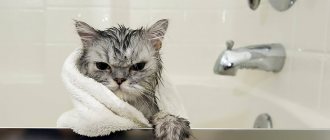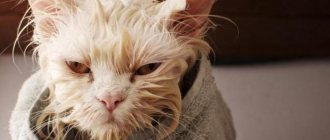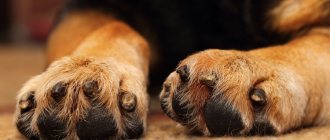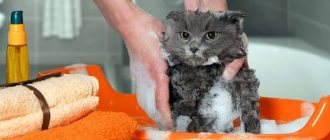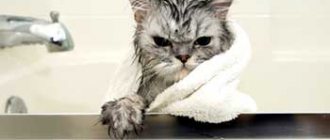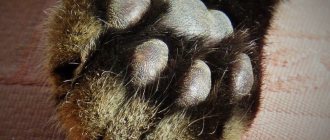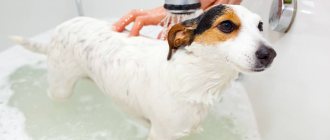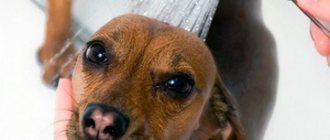Why wash your pet's paws?
First of all, paws are washed not because of visible dirt, but because of bacteria. They accumulate on the pads, and after a walk they quickly spread throughout the house. A simple cut, crack or wound is a pathway for accumulated bacteria to enter the body and cause illness. Therefore, it is not the cleanliness of the apartment that forces you to wash, although it is also important.
Dirty paws ruin expensive rugs and furniture. It is unlikely that washing paws is more difficult than cleaning an entire room after a pet has run through the puddles in the yard. In addition, carpeting cannot always be washed perfectly.
The dog just returned from a walk? This means that in addition to washing, the owner must check the condition of the pads for the presence or absence of inflammation and cuts. In warm weather, ticks and other parasites can be found between the fingers. If left untreated, this is also bad for health.
Should you wash your dog's paws after every walk?
How often should you wash your paws? Unlike bathing, which is done at least once every three months, there is no specific advice on when to clean paws. However, if the dog lives indoors, the owners clean its paws daily after a walk. Their contamination depends on the pet's activity level and the season. For example, hot summers and slushy winters are factors that make you wash your paws more often. A dog that spends most of its time outside and just wandering around the neighborhood may only need brushing every 1-2 weeks.
Important! You don't need a microscope to find out if there are bacteria on your paws. Just smell them. If there is an odor, then there is bacteria.
Subtleties of getting used to the procedure
Should you teach your pet to wipe its paws after a walk? Owners wipe their feet when entering a room, so why not the pet himself? It turns out that a dog can actually be taught a procedure that it may not like. But you should know that the animal will only wipe its front legs. Most dogs cannot be trained to wipe their backsides either.
Also keep in mind that wiping paws is not natural for a dog. Therefore, they will not be 100% cleaned if the dog wipes them on the rug.
What to do if your dog doesn't like to wash his paws
The paw is the organ through which the dog receives information from the outside world. Paws are very sensitive to tactile sensations. If the animal was caused discomfort during washing, provoking a primary feeling of fear, then negative memories will cause aggression and a reluctance to wash its paws.
The problem is solved by changing the nature of the procedure. For example, paws can be washed in a paw washer (a glass with bristles inside) or in a basin with a cloth. Perhaps the pet will agree to a different washing method.
Dog handlers advise correcting the situation through correcting incorrect behavior. Start training the animal, and gradually you will be able to achieve calm behavior from it:
- Step 1. The training begins with the command “Give me your paw.” When your pet does it, hold the paw in your hands and shake it, as if you were saying hello to a friend. Gradually increase the amount of time you hold your paw without your pet taking it away. Reward if the dog behaves correctly.
- Step 2. Cover your hand with a towel and ask your pet “Give me your paw.” He needs to get used to having fabric touching his paws.
- Step 3. If the previous two steps do not raise any questions, then you can rub your paw with a towel while executing the command.
Now you are ready to dry your paws with a wet towel using plenty of water.
Did you know? There are more than 150 dog breeds in the world. The most popular ones
—
Labrador Retriever, Golden Retriever, German Shepherd, Beagle and Dachshund.
How to train a dog to wash its paws
In addition to training the animal, it is imperative that your pet is taught to wash its paws from an early age. Upon arrival home, you need to give the animal the command “Sit” and wet its limbs in a previously placed basin of water or using a paw wash. For pocket dogs, it is preferable to use the bathroom.
Over time, the animal will get used to this manipulation. When trying to escape, you should not scold your pet. To speed up the adaptation process, it is advisable to reward your four-legged friend with your favorite treat.
How and what to wash your dog after a walk
Preparing for washing:
- It is important to check the paws before lathering them. Debris may get stuck between your fingers. They search for and remove everything that shouldn’t be there. For example, tiny pebbles, broken glass shards, shells or other material. If a splinter or something embedded in the pads is found, it is carefully removed.
- Then they move on to trimming the hair on the bottom of the paws so that it does not get tangled. This will help prevent the growth of bacteria, unpleasant odor and bacterial infection of internal organs. The length of the coat after clipping should be approximately equal to the height of the pads.
Classic paw washing technique:
- After checking your puppy's paws and trimming the fur, wet the paws with water.
- Lather with mild dog shampoo and rinse.
- Dry your limbs with a towel. It is important that your pet does not slip. Wet paws will slip on linoleum or tile floors, which can cause injury.
If you want to do a routine paw cleaning after a brisk walk, gently wipe the paws with a washcloth and water. For an even more convenient option, the American Kennel Club recommends using wet wipes that are safe for dogs.
Paw washes
To wash your paws you need:
- any shampoo;
- water;
- clean cloth.
In addition, there are products that are designed specifically for dog paws. If such shampoo is not available, use baby soap or baby shampoo. It will have the most gentle effect on the skin.
The formula of a specialized shampoo for washing paws includes:
- vitamins to improve the condition of skin and coat;
- keratin.
They penetrate deep into the skin, where they have a healing, nourishing or moisturizing effect. The type of effect depends on the composition of the specific product.
Did you know? Catahoula Leopard Dog
-
the best climber among canines.
Thanks to the special shape of its paws, it can climb trees. The Mudbuster Paw Cleaner, or something similar, will be an excellent assistant in daily procedures. It is shaped like a glass with delicate synthetic fibers inside. Available in several sizes. Therefore, you can easily choose a paw wash that will suit the size of your dog.
If you need a deeper cleaning than rinsing in a paw washer, use cleansing wipes. Baby wipes work too. They provide a more thorough cleaning than a simple cloth and disinfect the skin. For pets with sensitive skin, buy unscented wipes.
How to quickly wash your paws with a paw washer
Using the paw washer is very simple:
- Some owners add only clean water to the container. Others use water with a little shampoo.
- Then insert the pet's paw into the reservoir one at a time and rotate the paw wash around it to remove dirt.
- At the end of the process, the paw is removed and dried with a towel.
How to wash your dog's paws after a walk during coronavirus
Today there are no proven facts indicating that dogs suffer from coronavirus or can become its carrier. There is only one known case of dog infection in Hong Kong. But the source reporting the infection is not reliable. Therefore, there is no need to worry about the health of your pet, but it is necessary to follow the rules of hygiene.
When walking, it is recommended to adhere to the following rules:
- Don't walk in crowded places.
- Go outside for short periods of time.
- Do not allow your pet to come into contact with other animals.
- Be sure to provide physical activity. Take exercise equipment or your favorite toy with you for a walk.
- Don't let them pick things up from the ground.
- When you return home, be sure to treat your hands with antiseptic after petting your dog.
- At home, treat your paws with an antiseptic, and then proceed to washing.
Important! If the dog is unwell, you still need to walk it. Its paws are wiped with special wipes, but not washed, as stress will negatively affect the health of the animal.
What not to do
You should not give your dog unpleasant associations with washing. If the pet categorically refuses to wash itself, then it needs to be reassured. And then wipe the paws with a damp cloth or choose another cleaning method.
Don’t put your dog in the bath straight away, start with small containers
Not all pets like bathing in the bath, and it is impossible to explain to an animal that you are not going to give it a full bath, but only want to wash its paws.
Dogs may be frightened by the sound of water running from the shower or by the fact that their paws move on a slippery surface. Often, all attempts to wash an animal’s paws in the bathtub end with the dog starting to whine, dodge the stream of water directed at him, and may even jump out of the bathtub, run away and hide.
So that the dog is not afraid of washing its paws in the bathroom, and at the same time is more relaxed about bathing, it is necessary to gradually accustom it to these procedures. At the same time, at first you do not need to try to carry them out in the bathroom, but it is better to start with smaller containers, for example, with a basin or a large bowl if the pet is a dwarf breed and wash its paws not in the bathroom, but in the hallway.
You can also purchase a special device called a paw washer, which will not only make the life of the owner and his pet much easier, but will also save them both from the need to go to the bathroom every time after a walk.
This device is especially convenient when the bathroom is located at the opposite end of the apartment and it is impractical to take the dog there after every walk.
Recommend: Egyptian Mau
True, training a puppy to use a paw wash can also take some time, since not all pets like to use them.
3. Use an anti-slip mat in the bathroom from the first wash so that the dog does not get injured and feels confident.
Lifehacks for different situations
A dog in overalls on a walk has not surprised anyone for a long time. And owners of animals with sensitive skin are advised to buy shoes for their pets. This lifeguard protects paws from extreme temperatures and prevents dirt buildup. There is also a drawback. For example, teaching a dog to walk in special shoes is difficult. After all, the animal instinctively begins to free itself from the interfering object. Therefore, the owner of a dog wearing shoes should be considered a talented trainer.
To reduce dirt getting into the room, place a mat by the door and train your dog to step on it. Most of the dirt from the street will remain on the rug.
Washing paws for large dogs
The problem with large dogs is their weight and the lack of containers of a suitable size. If it is difficult for an animal to enter the bathroom or the owners want to reduce the area that will need to be washed after the procedure, then they adapt a large basin or baby bath for washing. First, the front paws are washed in it, and then the hind paws.
In the summer, especially in private courtyards, owners equip a washing area. This may be a small area covered with a rubber mat. The source of water is a regular garden hose connected to a water supply.
Washing paws for small dogs
A small dog can be washed in any container. For example, in the washbasin, and wipe next to it on a small table. Those who wash their pet in the bathroom will need a special seat that rests on the sides. The seats are produced for older people with musculoskeletal disorders. But it will also suit a small dog. The hostess will not have to bend over. Paws will not slip on a wooden surface. The animal feels confident and is not nervous during the process.
There are other lifehacks. The special Moyjack insert is like a soft box made of synthetic waterproof material. It is fixed inside the bathtub, and the dog is placed in it and washed. "Moyjack" is convenient because the paws do not slip. The material also protects the bathroom surface from dog claws. An additional advantage of the design is that it can be used as a carrier and sleeping place for a dog during summer travel.
Important! Some animals perceive the noise of tap water as threatening. Therefore, when washing small dogs, it is recommended to use a gentle shower instead of running water.
Washing paws for furry dogs
Washing furry paws is no different from those with shorter coats. Just remember to trim the fur so it doesn't exceed finger height.
What you might need to wash your paws
To keep your pet's paws clean and healthy, it is advisable to purchase the following things:
- Basin with water . It is placed either near the front door or in the bathroom. If you are washing your dog in the bathtub and are concerned about clogging the drain with dirt and debris, you can place a basin or baby bath directly in the bathtub. After washing, flush the water into the toilet.
- Anti-slip bath mat . It is especially important when the dog is accustomed to jumping out of the bath on its own after washing - at this moment it is easy to slip and get bruised.
- Dog shampoo or paw soap. Buy these products only in specialized stores and do not use human ones. Shampoo or special soap can be diluted in water, or you can apply it to a sponge and wipe the dog’s paws with this sponge. Don't get too carried away with detergents. Use them on heavily soiled areas rather than on an ongoing basis as they can dry out the skin.
- A cotton towel , or better yet two. One is to put a wet dog on it, and the second is to wipe it off.
- Microfiber cloths . They are good for removing small dirt. They absorb water well, dry quickly, and do not leave lint.
- Wet wipes – these can be used after a walk in dry weather.
- Tar soap is useful if there are wounds or abrasions on the paws. It relieves inflammation and disinfects, and also accelerates the skin restoration process.
- Tweezers - in case there is debris (pebbles, pieces of glass, etc.) clogged between the fingers or under the claws.
- Autogel for hand washing . Gasoline and other automotive fluids cannot always be washed with soap, so it doesn’t hurt to purchase a special gel just in case. It removes fuel oil, oils, grease, and rust. It is unknown how a dog's skin will react to it, so only use this product when all else fails.
Pet paw care
Sensitive paw pads are regularly exposed to a variety of textures, from hot asphalt to salt and fertilizer on a treated lawn. The consequences of such contact are burns, irritation, dry skin and bacteria.
If simply washing your paws is not enough, prepare a medicated cream. If you notice a cut, redness or irritation of the skin, apply the medicinal composition to clean paws. It will soothe and protect the skin.
Wax helps protect against snow or autumn dirt. They cover the paw pads before a walk. As a result, an impenetrable antibacterial film is formed on them, which protects the skin from any chemically active substances.
